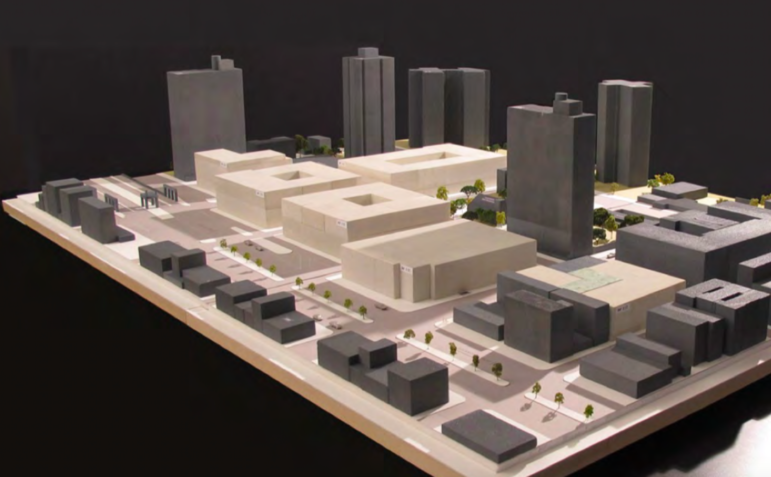
NYCEDC
A model of the Essex Crossing project
Amazon’s decision to withdraw its plans to build a second headquarters in Long Island City sparked dire predictions from many observers. Some argued it would now be impossible to attract significant commercial development in Western Queens, or that businesses would be discouraged from moving anywhere in the five boroughs. Many of us in the real estate community wondered if this signalled an end to the pro-growth political climate that helped drive the city’s incredible economic recovery over the past four decades.
Six months later, it now seems clear that these concerns were overblown. Amazon itself is reportedly looking to take more space in midtown Manhattan. And the City of New York has already been engaging community stakeholders around a new vision for the Long Island City site.
Treating the Amazon HQ2 project as a proxy for all new development was an error in judgement. Amazon’s nationwide competition and the media frenzy that followed put the focus on what New York City had offered to do for Amazon, rather than what this project would ultimately deliver for New Yorkers. Amazon failed to secure meaningful community input or community buy-in. James Patchett, president and CEO of the New York City Economic Development Corporation, who led Amazon negotiations on behalf of the City, has noted that Amazon “never hired a single New Yorker to work for them, to talk to New Yorkers, and never really connected with people in the city.”
But the City of New York and the real-estate industry know how to develop ambitious projects hand in hand with communities in ways that ensure both local needs and citywide goals are being met. To see an example, simply look to the Lower East Side, where lots that sat vacant for decades have been transformed by a community-centric process into Essex Crossing.
Essex Crossing began when the local community board established guidelines for what was then known as the Seward Park Urban Renewal Area. Between 2009 and 2010, a committee led by experts from the Pratt Institute held a series of meetings with representatives of the many constituencies that would be impacted by any new development.
Their plan – the Seward Park Mixed-Use Development Project – called for preserving the neighborhood’s character through contextual design, while producing mixed-income housing, cultural amenities, and retail space. That plan ultimately informed the City’s public bidding process and led to the selection of the Essex Crossing development team, Delancey Street Associates LLC, a joint venture of L+M Development Partners, BFC Partners, and Taconic Investment Partners.
Ten years later, long-vacant lots have been replaced by a group of buildings that are distinct yet cohesive in their design, fitting seamlessly into the surrounding neighborhood. There are amenities that serve long-time residents, like a much-needed supermarket, while 500 permanently affordable apartments will help make sure that the Lower East Side remains accessible for new generations of New Yorkers.
The centerpiece of that development – a new and improved home for the historic Essex Street Market – officially opened to the public just a few months ago. The New Essex Market is an example of what makes the project as a whole so special: protecting longstanding vendors reflecting the neighborhood’s history and expanding opportunities for innovative food startups looking to the future.
These are just some of the reasons that our organization, the Urban Land Institute New York, selected Essex Crossing for an Excellence in Mixed-Use Development Award earlier this year. But this project is far from the only evidence that inclusive, community-driven planning is alive and well in our city.
Within the last few years, neighborhoods from Hunts Point to Far Rockaway have come together to develop comprehensive visions for growth and have invited investment from both the public and private sectors, resulting in further sustainable development, additional job opportunities, and more affordable housing in the region The same can and must be done in Long Island City.
It will require our government officials, community stakeholders, and the development community to work collaboratively to develop a shared vision for the future of Long Island City. But the advocates and elected officials who opposed the Amazon project have a responsibility here as well, and an opportunity to prove that being anti-Amazon doesn’t mean being anti-development.
Get the best of City Limits news in your inbox.
Select any of our free weekly newsletters and stay informed on the latest policy-focused, independent news.
These individuals must come to the table and work collaboratively, embracing the type of development approach we have seen succeed at Essex Crossing: development that serves the needs of both current and future residents and that protects neighborhood character, but recognizes that no neighborhood exists as an island and that the future of our city depends on smart and sustainable growth.
If we can come together in this way, history will remember Amazon’s departure as an anomaly rather than as the shape of things to come.
Felix Ciampa is the Executive Director at Urban Land Institute New York.









2 thoughts on “Opinion: Avoid Another Amazon by Learning from Essex Crossing”
Nicely written! One small detail: Amazon actually employs a number of staff in midtown, including senior product and engineering roles. Sorry, I don’t know the headcount but it’s hardly zero.
Seriously? SPURA/Essex Crossing sat empty for decades, because no one could agree on what to do with it. Eventually, the council member threw in Elizabeth St. Garden (which should never have been part of EC), and she rigged a deal that few wanted. Essex Crossing is a good example of NOTHING. Felix, you must be pulling our leg. Yikes!